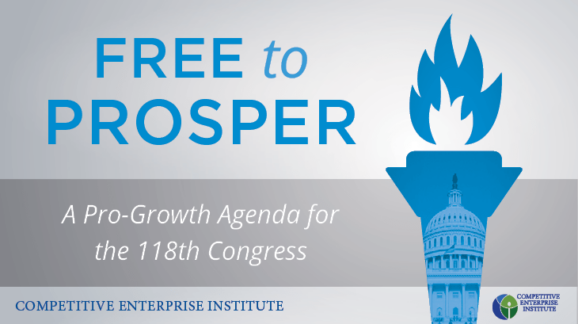Free to Prosper: Transportation
Mobility for both people and goods is one of a modern economy’s most important needs. The COVID-19 pandemic changed our transportation patterns considerably and put significant stress on existing transportation networks. Passenger transit usage crashed, putting those systems under financial strain. Commuting patterns changed, raising questions about whether there would ever be a return to “normal.” Consumer demand increased, leading to unprecedented pressure on supply chains in peacetime—since compounded by war in Europe.
Interstate Trucking
Current federal limits for interstate truck gross vehicle weight (GVW) are set at 80,000 lb. with a maximum of five axles. However, all 50 states allow higher GVW trucks to transport goods within their borders, mostly via state or local roads. The lower interstate limit increases:
- The number of trucks needed to carry goods
- Demand for drivers in a tight labor market
- Emissions
- Traffic congestion
All of these factors lower the trucking industry’s competitiveness against freight rail. Many current trucks are capable of hauling higher weights but instead run only partly full for part of the routes, a fact that underscores the inefficiency of the current weight limits.
To alleviate this, Congress should authorize an opt-in pilot program for states to test the effects of increasing the federal GVW to at least 91,000 lb. on six axles. The pilot program would enable the federal government and the states to assess the safety implications of higher GVW, although a 10-year pilot program in Idaho found no evidence of decreased safety. Moreover, several European countries allow 44-metric ton (97,000 lb.) trucks with no appreciable safety concerns. In fact, the European Union, which is well known for a precautionary approach, is considering increasing its current 40-metric ton weight limit to 44 metric tons across the continent.
The pilot program would immediately reduce strain on the supply chain, lessen the need for more truck drivers, and reduce congestion. According to the Rocky Mountain Institute, which places a considerable premium on emissions reduction, it will also significantly reduce carbon emissions. As such, it represents a “no regrets” emissions policy—one that reduces emissions but is worth doing even if emissions do not present a threat.
As for infrastructure concerns, studies have found that the addition of a sixth axle reduces wear and tear on road surfaces by 37 percent. The current federal bridge standard is already compliant with a 91,000 lb. weight limit.
The opt-in pilot program should accommodate as many states that show willingness to participate in order to maximize the collection of useful data.
Highway Funding
The starting point for sound transportation policy should be adherence to the user- pays–user-benefits principle. Transportation infrastructure and operations should be paid for by the users who directly benefit from them. Despite some spillover effects, the vast majority of benefits accrue to the transportation network’s users.
Compared with general revenue funding of government-owned infrastructure and services, user-pays offers the following advantages:
- Unlike tax dollars that wind through convoluted bureaucracies, charges “follow” users.
- Users pay and benefit directly from improvements generated from their payments; users who use the systems more pay more.
- Signaling of Operating revenues generally track use, and popular systems can be identified for targeted improvements.
Unfortunately, many federal transportation programs do not adhere to the user-pays principle. In those cases, the programs should be reformed to meet the user-pays principle through methods such as tolling. If that proves not to be possible, it suggests that the program has high costs and low value and should be eliminated.
This principle is particularly important as Congress considers what to do about the federal gas tax and the Federal Highway Trust Fund for which it provides revenue. As more and more drivers turn to electric vehicles, the gas tax will be paid disproportionately by owners of older vehicles who are likely to be less affluent. In order to ensure that the Trust Fund has a consistent source of revenue and to ensure fairness for all road users, a replacement will need to be found.
Mileage-based user fees (MBUFs) are in many ways a direct replacement for the gas tax, reflecting the same user-pays–user-benefits principles. Congress should expand existing pilot programs to better assess the feasibility of this mechanism and to address drivers’ privacy concerns. Congress should be wary of attempts to impose
MBUFs in addition to the gas tax. The fees are unlikely to be seen as acceptable if they simply increase the cost of travel.
